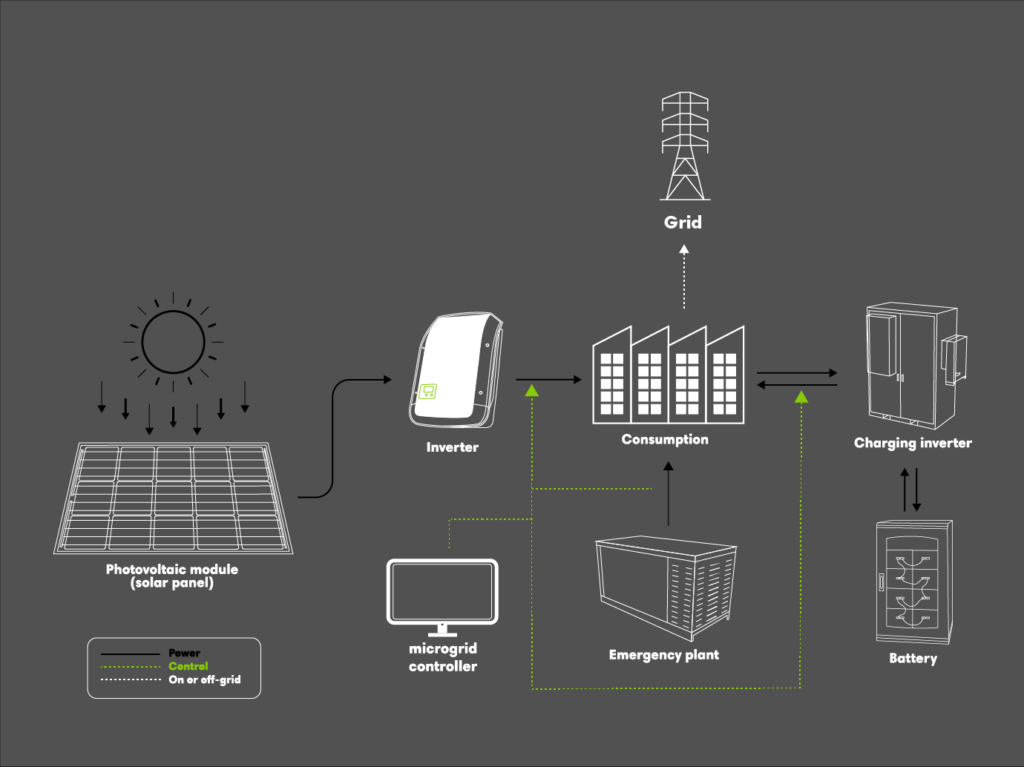What is an electric microgrid?
In this blog we will explain what is an electric microgrid, its applications and why it is the trendy amongst commerce and industries. greenenergy® started installing microgrid on early 2021, with the microgrid for Marriot Belén Hotel, the first of the chain to install this technology in Latin America.
What is an electric microgrid?
An electric microgrid is an integrated system for the generation and management of low and medium voltage energy. It is similar to the voltage level of a house. A microgrid includes solar panels, storage batteries, energy inverters and a software that controls the generation, storage and management of the energy produced. It can be controlled as an individual entity that works together with the public network, or be intentionally isolated (off-grid).

What is the difference between a microgrid and a traditional on-grid photovoltaic solar system?
A traditional photovoltaic solar system offers energy coverage and savings in the electricity bill of any home or business, but it does not offer energy security. So, in case that the national electrical system fails, the system will shut down, leaving the house or business without energy. Even if you have a traditional photovoltaic system installed. However, when we introduce storage equipment (batteries) to a traditional system, it becomes a microgrid. This keeps the home or business partially or fully energized. In essence, any traditional photovoltaic project aspires to become a microgrid at some point. It is important to get experts’ assessments who understand the technical challenges of how to do this and thus achieve that aspiration.
What are the benefits of a microgrid?
In residential cases, the idea is to offer energy security. This allows the energy consumption of the house to be sustained for a defined period of time. The true benefits or potential of a microgrid are at an industrial level. Depending on the application of the equipment, a microgrid offers specialized options such as management of demand peaks, energy arbitration, power factor compensation, among others. With a microgrid, you have control over the energy consumption and the savings on the bill are maximized.
How does an off-grid system differs from an electric microgrid?
An off-grid system is an off-grid microgrid. A microgrid that works with the public grid is one that is interconnected to the grid but has the option of going off-grid if something happens (for example an electrical shutdown, deficient energy quality, etc.). The control system of the microgrid is the one that decides whether or not to go off-grid.
So, a site with a microgrid no longer needs an electric power plant?
Not necessarily, it all depends on the needs, opportunities, and context of that site or client. When there is a microgrid, the electric power plant should be the last resource used. Every time you start a power plant, there is a massive diesel consumption and a big carbon dioxide footprint. However, in some cases, an electric power plant is a useful resource to react to some electric fluid phenomenons. When we talk about an off-grid microgrid, we recommend to have an electric power plant, to add up an extra layer for electric security.
When to use an electric power plant if I have a microgrid?
The general idea is that the emergency plant is the one that responds first when there are sudden changes in the electric fluid. Its ease to return to the active loads of the clients is fast. Subsequently, its use is relayed to the storage system. In case there is sunlight, it’s relayed to the photovoltaic energy. However, it depends on the applications. When we talk about storage, there shouldn’t be cookie cutter recipe. The same equipment might work differently depending on the client’s energy consumption culture and the case study. That’s why it is important to rely on companies that are able to model these applications. We recommend electric power plants for industries and commercial sites.
How long does the energy stored on the microgrid’s batteries last?
It all depends on the design created along with the client, depending on its needs. In the industry, there is a common practice of “packaging” he equipments, to make them “plug-and-play” solutions in order to not depend on unexperienced third parties to integrate the system. This practice has been standardized and most known manufacturers have one hour (1h), two hours (2h) or three hours (3h) solutions. However, at greenenergy® we have the needed experience for designing and integrating systems, that go beyond the conventional catalog of an specific brand, because for us, the priority is our client’s needs and modeling and designing something specific for each one of them.
What is the cost of a microgrid?
We cannot estimate the cost since the systems are custom made and vary between each client. Factors such as the electric power consumption, location, and currents assets on the site are game changers. Also the opportunities the site has, such as access or not to the public grid, quality of the grid’s energy, amongst others.
Who are candidates for having a microgrid?
Commercial and industrial sites are by default the ones that have a higher energy consumption. Therefore, a microgrid would complement and benefit radically the operation. Homes that have high energy consumption or want to be off-grid, could qualify to have a microgrid.
Interested in having more information?
Contact us to get a quote!.
Written by: Ignacio Salazar, Commercial Director at greenenergy®
